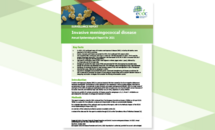Invasive meningococcal disease - Annual Epidemiological Report for 2021
Invasive meningococcal disease (IMD) is a serious bacterial infection caused by the Gram-negative diplococcus Neisseria meningitidis. The bacterium is often detected in the nasopharynx without causing disease, described as asymptomatic carriage. It occasionally invades the body and causes meningococcal infection. IMD is a major cause of meningitis (37%–49% of cases) and septicaemia (18%–33% of cases). It is of public health concern because of its severe morbidity and relatively high case fatality rate (8–15%), especially in young children.
Download

Invasive meningococcal disease - Annual Epidemiological Report for 2021
- EN - [PDF-1.07 MB]







